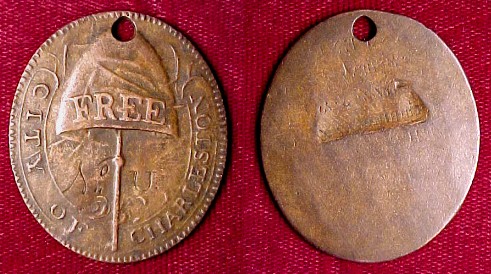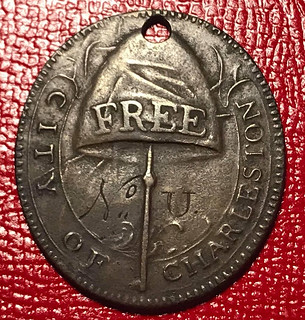
PREV ARTICLE
NEXT ARTICLE
FULL ISSUE
PREV FULL ISSUE
THE CITY OF CHARLESTON FREE BADGEResearcher John Kraljevich posted a great article on Facebook about the City of Charleston Free Badge. With permission, we're republishing it here. -Editor
• Why do we have Black History Month? • Why didn't I ever learn about any of this stuff in school, beyond Jackie Robinson and George Washington Carver and maybe Harriet Tubman? • Is Black History Month really necessary anymore? I think all of these questions are best answered by teaching one concept. The past is everything that happened before this moment: good and bad, famous people and anonymous people, moments and storylines and broad themes. If it happened before right now, it's the past. History is the story we choose to tell about the past. The history we learn in schools tends to be a story about presidents and generals and wars and endless progress. But there are lots of histories, in fact, there are infinite histories. And that means "history" isn't right or wrong, nor is it ever complete. It is always an edited, even biased, version of a narrative about the past. In America, the dominant narrative begins in 1607 or 1620 and tends to be very white and very male. Non-coincidentally, the victors of most of the struggles and the writers of most of the history tended to be the same. Black History Month offers an opportunity to tell a different narrative. Too often (for my taste at least), it's a narrative about the same handful of freedom fighters, a lot of very famous entertainers and athletes, and perhaps a scientist or two. But African-Americans since 1607 (or earlier, if you wish) have faced struggles no other group have faced (please, you don't want to come at me with tales of "Irish slavery," I promise you) and thus have seen successes that no other group can claim. Sure, there were a million banks, but the Douglass National Bank of Chicago -- the first black-owned national bank -- was special. Of course, there were a million historians, but W.E.B. DuBois’ entire career and perspective represented generations of hard work distilled through his pen. And certainly, there were other poetesses of the Revolutionary Era other than Phillis Wheatley, but none so captured the imagination of the era that declared All Men Are Created Equal, nor offered so much contrast, than a woman of letters who was born free in Africa, enslaved, and emancipated. Phillis Wheatley was legendary in her day, feted by the Founders. She died in 1784, when her husband was in prison, just months after the death of her infant child. Her only remaining child, also an infant, died soon enough thereafter to be buried with her mother. I collect a lot of things, but collecting numismatic (related to coins, medals, and paper money) items related to African-American history is my most intensely pursued specialty. This month, I'll share some items from my collection. This first piece is the object of which I'm most proud, but it also illustrates some of the points of this post. History is the story we choose to tell about the past. And the story we tend to tell in the United States is a tale of progress moving upward and onward, endlessly better, climbing the mountain of righteousness. The illustrated object is a badge from the City of Charleston, South Carolina, issued only between 1783 and 1789. It depicts a freeman's cap, called a pileus, on a pole, a symbol of liberty that was common during the Revolutionary War and the decades that followed. In the ardent spirit of freedom that followed the American Revolution, emancipations -- freeing enslaved African-Americans -- reached a height not seen for several decades after. As time went on, emancipations decreased, and as the Revolutionary generation passed, race-related laws and restrictions became harsher, more numerous, and more widespread. Many Southern states made emancipations all but illegal, and when they were permitted, emancipated people were ejected from the state on pain of re-enslavement. This badge, one of just a handful known to exist, is a relic of a brief period (just six years!) when a small number of African-Americans in Charleston could enjoy a brief flicker of relative freedom. It's a reminder that progress, especially for African-Americans, goes back and forth, one step forward and two back, and that our national ideals and the language used to describe them does not often match our national policies. This is as true in 2020 as it was in 1789. The person who wore this on their person was free in the decade that followed the American Revolution. We will never know if they remained free, nor if their descendants did. Though in my personal collection, this piece is on loan and will be displayed at Colonial Williamsburg through 2026. To read the complete article, see:
Thanks, John, for a great history lesson and a fantastic numismatic artifact. Saul Teichman located a super online article about these. Here's an excerpt. -Editor  Many exonumia collectors are familiar with the Charleston Slave-For-Hire Badges. Commonly called "slave tags," they were issued annually from 1800 to 1865 by the city of Charleston in an attempt to regulate the practice of slaves being hired out by their masters. Only a knowledgeable few, however, are aware of their earlier "cousins," the City of Charleston Free Badges. This is not surprising due to the relative rarity of the latter. Surviving slave tags probably number between one and three thousand, with new ones coming out of the ground on a regular basis. But the number of known free badges can be counted on two hands and the discovery of a new specimen is a noteworthy event. The author hopes this webpage will serve as a clearinghouse of information on the little-known free badges as well as an ongoing census for the same. The City of Charleston Free Badges, sometimes referred to as Free Black Tags or Freedmen's Badges, are thought to have been made in the last months of 1783 or early in 1784. In November of 1783, a city ordinance was passed which stated that "every free negro, mulatto, or mestizo, above the age of fifteen years, shall be obliged to obtain a badge from the Corporation of the City, for which badge every person shall pay into the City Treasury the sum of Five Shillings, and shall wear it suspended by a string or ribband, and exposed to view on his breast." The penalty for not adhering to the law was a fine of three pounds, and if not paid within 10 days the violator could be sentenced to the workhouse (jail) and hard labor for up to 30 days. The same law which required free persons of color to obtain and wear the free badges also attempted to regulate the practice of hiring out slaves. It set up fees for "tickets or badges" for hired slaves, as well as fines for those owners hiring out unticketed slaves and those who employed them. No slave tags exist with dates earlier than 1800 and it is thought that perhaps paper tickets were used instead of the usual brass badges which were instituted later. In 1789, the law requiring tickets for slave hiring and badges for free persons of color was abolished, and was not to be replaced until 11 years later (in 1800) with a new law governing only slave hiring practices. There was no mention of badges for free blacks in the 1800 ordinance, nor was there in any subsequent ordinances or regulations. Therefore, the time period in which free persons of color were required to wear badges lasted only six years, from November of 1783 until 1789. All existing free badges are undated and there was no wording in the 1783 ordinance calling for annual renewal, so apparently once the badges were issued, they were good "in perpetuity." These two facts - the short-lived nature of the ordinance calling for the badges themselves and the fact that they did not need to be renewed annually - may account for the relative rarity of the free badges. Additionally, there were less than 600 free blacks living in Charleston in 1790 (U.S. Census figures) and many of that number were undoubtedly children younger than 15 years of age. There is no mention in the 1783 ordinance as to what entity was to manufacture the free badges and no evidence has turned up in any official source as to the identity of the manufacturer. It is possible that they were made by a local silversmith or goldsmith, as the later slave tags were. (Slave tags from the early 1800s often had the manufacturer's name on them.) However, the style of the free badges differs significantly from the later slave tags. All known genuine free badges were die struck in relief on oval copper planchets (or in one case silver) by use of a single obverse die. A Phrygian cap (liberty cap) on a pole is the central device of the obverse, with the word "FREE" appearing on the lower edge of the cap. To read the complete article, see:
Wayne Homren, Editor The Numismatic Bibliomania Society is a non-profit organization promoting numismatic literature. See our web site at coinbooks.org. To submit items for publication in The E-Sylum, write to the Editor at this address: whomren@gmail.com To subscribe go to: https://my.binhost.com/lists/listinfo/esylum All Rights Reserved. NBS Home Page Contact the NBS webmaster 
|
